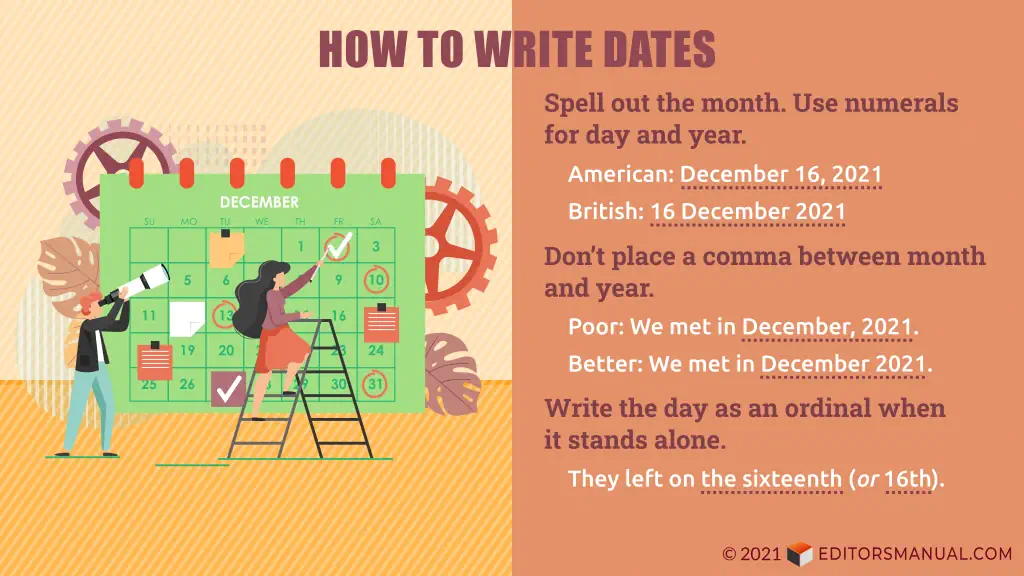
To write the exact date, spell out the month, and write the day and the year in numerals. The American date format is month-day-year, with a comma between day and year (May 1, 2022), while the British format is day-month-year, with no comma between month and year (1 May 2022). Don’t use ordinal numbers in dates in formal texts (May 1st, 2022). You may also show the day of the week (Sunday, May 1, 2022).
If only the month and year are shown, don’t insert a comma between the two (May 2022). To specify the day alone, write it as an ordinal number (We arrive on the first).

The American date format is month-day-year. In running text, spell out the month, and write the day and year in numerals. Use commas to separate day and year. Don’t use ordinals (st, nd, rd, th).
To set off the year, use commas in pairs: a comma must appear not just before but also after the year.
The British date format is day-month-year. The day and year are written in numerals, and the month is spelled out. No comma is needed between month and year. This system is also followed in much of Europe and the rest of the world.
When only month and year are specified, the month appears before the year. No comma is needed between the two.
The preposition “of” between month and year is unnecessary and omitted in formal writing.
When it is clear which year is being referred to, you may indicate only day and month. Spell out the month, and write the day in numerals. Remember that day follows month in American usage. Don’t use ordinal numbers (st, nd, rd, th).
In British and other European writing, the day appears before the month.
The use of ordinal numbers (st, nd, rd, th) in dates is unnecessary. Avoid it in formal writing.
In creative and other informal writing, the day and the month are often shown in words.
When only the day is mentioned, spell out single-digit numbers. Two-digit days may be either spelled out or written in numerals. Use ordinal numbers (st, nd, rd, th).
Style guides differ in their recommendations on whether to write numbers in numerals or words. Numbers under 10 are generally spelled out. The Chicago Manual of Style recommends spelling out two-digit numbers as well, while the AP Stylebook and APA Publication Manual suggest using figures for numbers from 10 onward.
When using figures, don’t set the ordinal in superscript (16th, not 16 th ).
To show a day of the week alongside a date, write the day followed by a comma, and then write the date. This can be helpful in appointments and invitations.
Dates may be written in all numerals. A numeric date format is used when the date is standalone—for example, in a signature. The U.S. date format is month-day-year, while the day-month-year format is followed by the UK and other nations. Slashes or hyphens are used to separate the parts of the date.
for May 11, 2021 British: Signed 11-5-21 for 11 May 2021 for November 5, 2021 British: Dated 5/11/2021 for 5 November 2021All-numeric dates are also written in the YYYY-MM-DD format, as specified by the ISO. This internationally agreed way to show dates is common in government, corporate, and other official usage. One of the benefits of this system is that it makes for easier sorting and storage of files and folders. In file names and data entries, hyphens are generally omitted.
Dates are generally written in words rather than numerals in creative writing and legal documents. Spell out the day and the month, but use numerals for the year.
In formal writing, follow the prescribed format of writing the day and year in figures and spelling out the month.
When part of a specific date, the month may be abbreviated. Write the first three letters of the month, followed by a period. Don’t abbreviate May, June, and July. In formal writing, abbreviations for dates are useful in tables and charts but avoided in running text.
In British style, the form is day-month-year.
In AP style, the abbreviations Jan., Feb., Aug., Sept., Oct., Nov., and Dec. are used. The remaining months are not abbreviated.
Periods may be omitted in informal usage, if there are space constraints, or in a fixed format, such as a table. The months June and July are also then abbreviated.
Use on with a date with the exact day. Use in to refer to the month or the year.